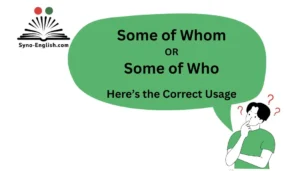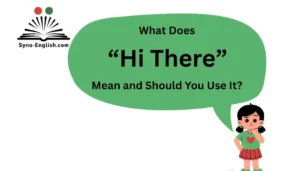When people say, “I am very much looking forward”, it reflects excitement and anticipation in the simplest, most polite way possible. Many language learners and native speakers wonder if it sounds overly formal or unusual, but the truth is that it’s widely used and perfectly acceptable in spoken and written English. As someone who has spent years teaching English, I’ve noticed how learners often add or remove words instead of just saying what feels natural. The phrase itself carries subtle nuances of tone, formality, and context, making it sound warm and polite, especially in professional or friendly conversations.
As a teacher and writer, I love to explore how expressions like these reflect deeper patterns of grammar and communication. In a comprehensive guide I created for my students, we examined its grammar rules, common mistakes, and alternatives. We also studied its historical roots, showing how English evolves and why such phrases feel natural in real-life situations. When learners understand that using “very much” simply emphasizes genuine feeling or excitement, they stop worrying about sounding formal and start sounding more authentic.
The Grammar Behind “I Am Very Much Looking Forward”
Let’s break the phrase into its grammatical components:
- Subject: I
- Verb phrase: I am looking forward
- Intensifier: very much
- Object: something you anticipate (always introduced by to).
For example:
- ✅ I am very much looking forward to meeting you.
- ✅ I am very much looking forward to the conference next week.
Here’s the key grammar point:
- The phrase “looking forward to” is a phrasal verb that always needs an object. The object can be either:
- A noun → I’m looking forward to the event.
- A gerund (verb + ing) → I’m looking forward to seeing you.
Without the “to” or without an object, the sentence is incomplete or incorrect.
Examples of incorrect grammar:
- ❌ I’m looking forward to you.
- ❌ I’m much looking forward.
Both sound unnatural and are grammatically wrong.
The placement of “very much” in the middle is acceptable because in English, adverbs can modify verb phrases. It acts as an intensifier, making the anticipation sound stronger and more polite.
The Role of “Very Much” in English
English uses intensifiers like very, really, so, quite, and much to add emphasis. “Very much” is a stronger form that adds weight and sincerity.
For example:
- I am looking forward to it → polite and neutral.
- I am very much looking forward to it → more emphatic, shows excitement or politeness.
Why Use “Very Much”?
- To sound more formal or polite in professional communication.
- To express deeper anticipation than just “looking forward.”
- To soften tone when writing emails or business messages.
Comparison with Other Intensifiers
| Phrase | Formality | Tone | Example Usage |
| I am looking forward | Neutral | Polite but plain | General statements |
| I am very much looking forward | High | Formal, polite, warm | Emails, business, interviews |
| I really look forward | Medium | Friendly, casual | Friends, informal workplace |
| I so look forward | Low | Very casual, modern | Texts, chats |
| I can’t wait | Very Low | Informal, excited | Friends, casual talk |
Correct Usage Examples of “I Am Very Much Looking Forward”
To see how the phrase works in different settings, let’s look at practical examples.
Professional Communication
- ✅ I am very much looking forward to our meeting on Friday.
- ✅ We are very much looking forward to collaborating with your team.
- ✅ I am very much looking forward to hearing from you soon.
In professional emails, “very much” adds politeness and warmth. It shows genuine interest without sounding too casual.
Casual Conversations
- ✅ I’m very much looking forward to the game this weekend.
- ✅ We’re very much looking forward to the trip.
- ✅ I’m very much looking forward to catching up with you.
Even in friendly settings, it makes the excitement sound more sincere.
Common Mistakes and Misconceptions
Even though the phrase is correct, learners often make errors.
Dropping “to”
- ❌ I’m looking forward you.
- ✅ I’m looking forward to you.
Remember: looking forward to always requires “to.”
Misplacing “much”
- ❌ I’m much looking forward.
- ✅ I’m very much looking forward.
“Much” on its own is incomplete. Pair it with “very” for proper emphasis.
Overusing the Phrase
In casual settings, repeating “I am very much looking forward” in every message can sound overly formal. Varying your expressions is more natural.
Alternatives to “I Am Very Much Looking Forward”
Sometimes you need variation depending on the tone or context.
Polite/Formal Alternatives
- I look forward to…
- I eagerly await…
- I anticipate…
- I am excited about…
Informal Alternatives
- Can’t wait for…
- Super excited about…
- Really looking forward to…
- Pumped about…
Comparison Table
| Expression | Formality | Best Context |
| I am very much looking forward | High | Professional emails, interviews |
| I look forward to | High | Polite, formal letters |
| I eagerly await | High | Academic, official writing |
| I can’t wait | Low | Casual, friends |
| Really looking forward | Medium | Friendly but still polite |
The Etymology and Evolution of “Looking Forward”
The phrase “looking forward” has an interesting history.
- Literal meaning (1500s–1600s): Originally, “look forward” meant to look ahead physically, toward the front.
- Metaphorical meaning (1700s): Began to mean “anticipate” or “expect.” Writers used it in letters when expressing hopes for future meetings.
- Modern use (1900s–today): Became standard in business English and polite communication. Adding “very much” became common in the 20th century to sound warmer.
Today, it is a staple phrase in professional communication worldwide.
Context Matters: Formal vs. Informal Usage
The tone of “I am very much looking forward” depends on where you use it.
Formal Settings
- Business emails
- Academic writing
- Job applications and interviews
- Networking events
Here, it signals politeness, respect, and genuine anticipation.
Informal Settings
- Chats with friends
- Text messages
- Social gatherings
While it still works, sometimes it may sound too formal. In casual talk, “Can’t wait” often feels more natural.
When Not to Use “I Am Very Much Looking Forward”
There are contexts where the phrase feels awkward.
- Overly casual conversations → Using “very much” with close friends may sound stiff.
- Negative or uncertain events → Saying “I’m very much looking forward to the dentist appointment” may sound sarcastic unless you truly mean it.
- Repetition → Using it in every sentence of an email reduces its effect.
Case Studies and Real Examples
Business Email Example (Correct)
Dear Mr. Ahmed,
Thank you for your time today. I am very much looking forward to continuing our discussion and exploring opportunities for collaboration.
Best regards,
Sarah
Job Interview Follow-Up
- ✅ I am very much looking forward to the possibility of joining your team and contributing to your projects.
- ❌ I’m much looking forward to your job. (Incorrect grammar and tone)
Casual Conversation
- Friend A: Are you coming to the concert?
- Friend B: Yes! I’m very much looking forward to it.
Quick Reference Guide
Correct vs. Incorrect
| Correct | Incorrect |
| I am very much looking forward to meeting you. | I am much looking forward. |
| We are very much looking forward to the event. | We are looking forward you. |
| I am very much looking forward to hearing from you. | I very much look forward to hearing from you. |
Do’s and Don’ts
Do:
- Use it in emails and professional contexts.
- Place “very much” before “looking forward.”
- Follow “looking forward” with to + noun/gerund.
Don’t:
- Drop the “to.”
- Use it excessively in casual chats.
- Write “much looking forward” without “very.”
Conclusion
The phrase “I am very much looking forward” beautifully captures warmth, enthusiasm, and respect in communication. Whether used by language learners or native speakers, it bridges the gap between formal and friendly English. Its grammar, tone, and formality blend naturally, allowing the speaker to sound both polite and genuine. Over time, the phrase has evolved through real-world contexts to express sincere anticipation without sounding exaggerated. It is more than a grammatical structure—it’s an emotional connector that reflects clarity, professionalism, and courtesy.
In today’s global environment, where every word carries meaning, mastering expressions like this can enhance your communication skills immensely. When you say “I am very much looking forward,” it conveys not just excitement but also thoughtful engagement and interest. It demonstrates confidence, politeness, and respect in both written and spoken English. Using it effectively ensures you sound approachable and considerate, especially in professional emails, meetings, or personal interactions. Understanding its grammar, nuances, and tone allows anyone to express enthusiasm naturally, making communication richer, smoother, and more impactful in real life.
FAQs
Is it correct to say “I am very much looking forward”?
Yes, it is grammatically correct and commonly used. It emphasizes genuine excitement and politeness in both formal and informal communication.
Can I say “I am looking forward” without “very much”?
Yes, but adding “very much” strengthens the emotion and sounds warmer.
Is this phrase too formal for casual use?
No, it fits naturally in both friendly and professional situations.
Where should I use this phrase?
Use it in emails, meetings, and conversations to express anticipation or excitement.
What does “very much” add to the phrase?
It adds warmth, sincerity, and emotional emphasis, making communication sound genuine.
Can I say “I look forward” instead?
Yes, “I look forward” is shorter but less expressive; “I am very much looking forward” is more heartfelt.
Why do learners find it confusing?
Because it sounds formal, but it’s actually a natural, polite expression in English.
How can I use it in business writing?
Say: “I am very much looking forward to working with you” — polite and professional.
Is it used in spoken English too?
Absolutely. Native speakers use it often in conversations to express excitement.
Does tone matter when saying it?
Yes, tone adds warmth and sincerity; saying it naturally makes it more genuine.




